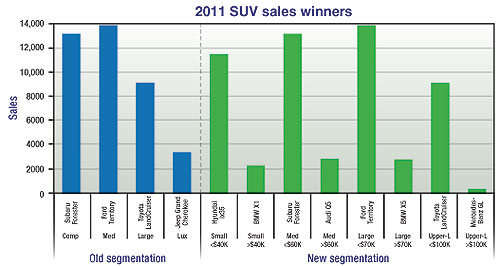News - Market Insight - Market Insight 2012Market Insight: FCAI sheds more light on SUVsLivin’ in luxury: Jeep’s Grand Cherokee was the ‘luxury SUV’ sales winner in 2011, but would have missed out on a top-SUV title based on the new VFACTS segmentation. Not everyone’s a winner as FCAI revises official sales segments for SUVs and others10 Feb 2012 By TERRY MARTIN NEW market trends and the need for more detailed classification of SUVs have prompted the Federal Chamber of Automotive Industries (FCAI) to revise its VFACTS reporting service, which details the all-important monthly new-vehicle registrations in Australia. Previously, the fast-growing SUV category – which now accounts for a quarter of all new-vehicle sales in Australia – was split between compact, medium, large and luxury segments. Now, however, following a review last year – which also studied, and revised, commercial vehicle segments – the SUV market has been rearranged based on vehicle footprint (width x length). Sub-categories based on a price threshold, as seen in passenger car segments, have also been introduced. As a result, the luxury SUV segment has now gone, with all models distributed among the following categories: small (under and over $40,000), medium ($60K), large ( $70K) and upper-large ( $100K). As GoAuto reported a fortnight ago in our Market Insight on ‘crossover utility vehicles’ – published before the new segmentation was announced – analysing this increasingly important genre proved somewhat difficult using the previous VFACTS classifications.  From top: Hyundai ix35, BMW X1, Subaru Forester, Audi Q5, Ford Territory, Toyota LandCruiser 200 Series. From top: Hyundai ix35, BMW X1, Subaru Forester, Audi Q5, Ford Territory, Toyota LandCruiser 200 Series.While different interpretations can still be made under the new system of what constitutes a micro-SUV – or certain models in other segments – the ‘small’ SUV segment creates a home for these so-called CUVs, bundling them in based on footprint and splitting them up based on price. The mainstream models include the Volkswagen Tiguan, Skoda Yeti, Mitsubishi ASX, Subaru XV, Nissan Dualis, Hyundai ix35, Jeep Patriot and Chery J11, while the ‘over-40s’ are, for now, listed as the BMW X1 and Mini Countryman. That now leaves the slightly larger SUVs from the former ‘compact’ segment – including big-selling models like the Subaru Forester, Toyota RAV4 and Nissan X-Trail – to move into the ‘medium’ segment, which was previously the domain of notably bigger SUVs such as the Toyota Prado and Kluger, Ford Territory and Holden Captiva. The FCAI now considers these to be ‘large’ SUVs, with even bigger models – namely the Toyota LandCruiser, Nissan Patrol, Range Rover, Lexus LX and Mercedes-Benz G- and GL-class – now known as ‘upper-large’. As well as prompting a change in the reporting of SUV sales/new registrations, the new classifications will enable car-makers to claim market leadership – and to use this, and examples of strong sales performance, in their marketing activities – in areas where they were previously not formally recognised. Last year, Subaru had the top-selling compact SUV in Forester, Ford’s Territory took medium SUV honours, Toyota again dominated the large SUV segment and Jeep’s Grand Cherokee topped the luxury SUV class over 22 other models of various sizes across a broad price spectrum. Under the new scheme, Hyundai’s ix35 was deemed the top small SUV last year, with BMW’s X1 claiming the top small SUV over $40,000 class. While Forester took out the medium-sized SUV class, Audi’s Q5 came out on top for medium SUVs priced above $60,000, and the Territory’s win – now assigned to the large SUV segment – was shared, to an extent, with BMW’s X5, which had a much lower sales volume but led the large SUVs over $70,000 segment. The Grand Cherokee, which comes in below the $70K barrier, now finds itself among the bigger-volume players in the so-called large SUV segment. And the result, as applied to last year’s figures, means it now loses its luxury SUV crown. LandCruiser is still king of the mountain when transferred from large to upper-large SUVs, with the Mercedes GL-class on top for the upper-large models above $100,000. For the record, the FCAI classifies SUV vehicles based on a wagon body style, ground clearance and design purpose, with the price banding “determined by the FCAI based on price relativity”. All SUV categories can include either 2WD or 4WD (or ‘AWD’) drivelines, but small SUVs are based on an engine with between four and six cylinders. Medium SUVs are defined as having an engine size of four to eight cylinders, large SUVs six to eight cylinders and upper-large four to 12 cylinders. The footprint is determined as follows: small (<8.1 square metres), medium (8.1-8.7m²), large (8.8-9.7m²) and upper-large (9.8m² and above). However, the FCAI told GoAuto: “These parameters are indicative only exceptions do occur based on market focus and other subjective criteria. They are largely based on the specifications listed and are reflective of the volume-selling variant where cross-over occurs.” For light commercial vehicle VFACTS segments, the FCAI has removed the previous ‘van’ segment and introduced a van/CC (cab chassis) segment split into two weight-determined categories: <=2.4t and 2.5-3.5t. Buses are also now shown in two segments, with the number of seats as the determinant (<20 seats and => 20).  Read more |
Click to shareMarket Insight articlesResearch Market Insight Motor industry news |















Facebook Twitter Instagram